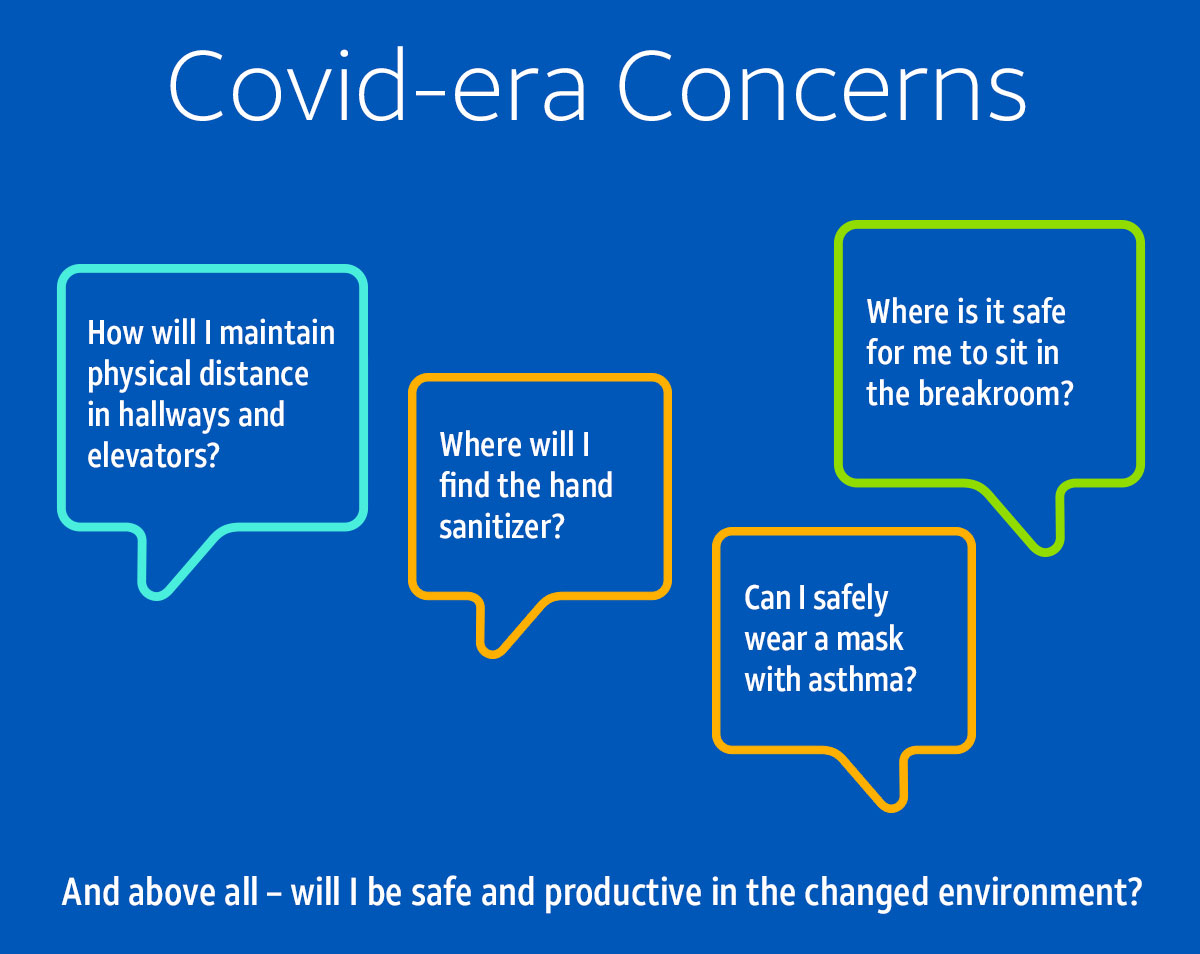As employers and staff across the U.S. consider workplace changes in the era of COVID-19, countless details – masks, sanitizers, workstations and more – have received ample consideration. Yet, despite the best laid plans, employees with disabilities will no doubt face additional questions based on their own, unique situations.
“COVID-19 has taken accessibility to another level,” explains Anne Roberts, lead accessibility solutions engineer with the Chief Accessibility Office at AT&T. “As we journey through this extended time of quarantine and plans for returning to the office continue to evolve, the stakes for the disability community are higher than ever. This is a very serious virus, and for people with disabilities, there is not a one-size fits all approach.”
In this ever-changing environment, a commitment to accessibility becomes even more important – and requires new considerations. We sat down with Anne recently to discuss some of the ways organizations can keep this important priority front-and-center as they plan to bring people back into the workplace.
1. Make it safe to self-disclose.
It’s hard to help without knowing who has a disability and how they’re affected. That’s why it’s so important to encourage employees to self-disclose safely and request any accommodations ahead of time. For those with known disabilities, reach out to ask if they have additional needs. Check in over time by different methods – for example, surveys, one-on-one conversations led by managers and outreach by a designated HR team member. “Ultimately, says Anne, it comes down to trust and clear communication. Simply asking the questions, ‘What is best for you? What is your preference?’ can go a long way.”
2. Allow ample time to plan and consider the details.
No detail is too small when considering potential barriers for those who have accessibility needs. “Think through the challenges that people with various disabilities might encounter in their work routines and plan ahead to address them,” she suggests. “Spend time considering multiple perspectives and definitely ask for input from individuals with disabilities.” Here are a few examples:
- Keep food areas safe. People who are blind or have low vision can be accustomed to asking for direct assistance when ordering or consuming food. Minimize the need for close contact. Work with vendors to make sure food is clearly labelled, provide accessible signage and train staff to identify and provide help, safely and respectfully.
- Make communicating through masks possible. Without the ability to see facial expressions and lip movements, those who are deaf or hard-of-hearing could miss important cues and information. Be proactive: provide masks with a clear panel and encourage their use.
- Provide directional markings and signs that are perceivable to all. For those who are color blind, the use of colors alone to indicate where people should and should not sit or stand will not be apparent. Use symbols alongside color to ensure important information is communicated in a way everybody can understand.
- Design new processes – temperature scans, handwashing, etc. – for everyone. Consider each process from the perspective of people with different disabilities. Someone with a mobility issue may not be able to pick up a thermometer – or read the results – for a temperature scan. Make alternative methods available. And, place hand sanitizer in consistent locations throughout a facility – including an easy-to-reach height for someone using a wheelchair or other mobility device.
3. Engage managers on the frontline.
As employees’ first and most vital link to their organizations, supervisors play a crucial role. Their skills to engage in respectful, productive dialogue about employee needs related to disability can go a long way to enacting effective solutions. Supervisors also help the whole team work together effectively, both remotely and in physical workspaces. “Educate them,” says Anne. “Invest the time to implement training on accessibility and job accommodations for supervisors. For many, it will be a learning curve. Set them up for success by providing information and support to build their confidence and understanding of how to work with employees of differing abilities.”
4. Apply the ‘Rule of 3’ to communicate for diverse needs.
Deliver all mission critical information in at least three ways: written (email, signs, articles, letters), video and verbal (meetings, conversations). People consume, learn and process information differently, so we need to combine a variety of channels for health and safety messages to reach everyone. “It’s important to share information in different ways across numerous platforms and mediums. Various modes are essential to make critical messages clear, understandable and actionable,” says Anne.
5. Seek input and test new systems – adjust where needed.
As workplace plans emerge and evolve, review them with employees, perhaps starting with members of employee resource groups, or other staff who have self-disclosed. Walk them through plans and ask for their input. If appropriate, ask this group to test new systems and processes and observe how it goes, noting any issues and then addressing them based on the input you gather. “Nothing beats asking,” says Anne.
According to Anne, if the pandemic has a bright spot, it would be increased awareness to the challenges those with disabilities face every day. “I am having conversations I would never have had before with leaders and staff who are now rethinking their approach to many things in the workplace. More people are realizing that they have coworkers with different abilities, and they are learning, hands on, how they can work with them and communicate better so that everyone is safe, comfortable and productive.”
Despite the many challenges, Anne remains hopeful that learnings from this unparalleled time will become ‘business as usual.’ The outcome: a world more welcoming to all. “Let’s return to the workplace better equipped and just plain better – in terms of accessibility, inclusion and belonging,” she concluded.






